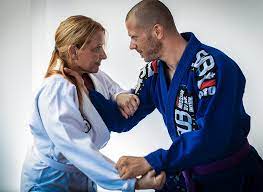Kickboxing Women vs Men: Unveiling the Differences and Similarities
1. Introduction
Kickboxing is a dynamic combat sport that requires a combination of agility, speed, strength, and mental focus. While the sport has traditionally been dominated by men, more and more women are stepping into the ring, embracing the physical and mental challenges that kickboxing presents. In this article, we will delve into the world of kickboxing, exploring the similarities and differences between men and women in this exhilarating sport.
2. History of Kickboxing
Kickboxing traces its origins back to ancient martial arts practices in Asia. It evolved as a way for fighters to utilize both their hands and feet in combat, combining the techniques of punches and kicks. Over time, kickboxing gained recognition as a formal sport, with the establishment of various organizations and governing bodies promoting its growth.
3. Kickboxing Techniques
3.1 Basic Strikes
In kickboxing, both men and women learn a range of striking techniques. These include punches, kicks, knee strikes, and elbow strikes. The fundamentals of these strikes are taught to beginners, gradually progressing to more advanced combinations and techniques.
3.2 Footwork and Defense
Proper footwork is essential in kickboxing, allowing fighters to move swiftly, maintain balance, and evade opponents’ attacks. Women and men alike focus on footwork drills and defensive maneuvers to enhance their agility and protect themselves during matches.
3.3 Clinching and Grappling
Clinching and grappling are integral parts of kickboxing, particularly in Muay Thai-based styles. Fighters engage in close-range combat, utilizing clinches to control their opponent’s movements and launch strikes. Both women and men practice these techniques to develop well-rounded skills in the ring.
4. Physical and Mental Benefits of Kickboxing
4.1 Fitness and Strength
Kickboxing offers remarkable physical benefits for both women and men. The intense training sessions and rigorous workouts enhance cardiovascular endurance, strength, and overall fitness. It helps burn calories, build lean muscle, and improve flexibility, leading to a sculpted physique.
4.2 Stress Relief and Mental Well-being
Kickboxing serves as an outlet for stress and a means of enhancing mental well-being. The high-energy nature of the sport releases endorphins, reducing anxiety and boosting mood. The mental focus required in kickboxing helps individuals improve their concentration, discipline, and self-confidence.
5. Training Approaches for Women and Men
5.1 Conditioning and Strength Training
Kickboxing training includes a combination of conditioning and strength exercises. Women and men undergo similar training routines to improve their endurance, power, and overall physical capabilities. However, trainers may tailor workouts based on individual needs and goals.
5.2 Skill Development and Technique
Both women and men focus on skill development and technique refinement in kickboxing. Training sessions involve learning various combinations, perfecting form, and practicing defensive maneuvers. Coaches provide guidance and feedback to help fighters progress and reach their full potential.
5.3 Self-Defense Considerations
Kickboxing equips individuals with practical self-defense skills. Training emphasizes awareness, situational analysis, and effective counterattacks. Women may receive additional training on self-defense techniques specific to real-life scenarios, empowering them to protect themselves.
6. Competitions and Tournaments
6.1 Professional Kickboxing
Professional kickboxing events showcase the skill and dedication of both women and men. Competitors participate in various weight classes, adhering to specific rules and regulations. Promoters and organizations strive to provide equal opportunities and recognition for female kickboxers.
6.2 Amateur Kickboxing
Amateur kickboxing tournaments offer aspiring fighters a platform to test their skills and gain experience. These events encourage participation from women and men at all skill levels, fostering growth and talent development within the sport.
6.3 Gender Categories and Regulations
To ensure fair competition, kickboxing features separate gender categories, accounting for physiological differences. Organizations establish weight classes and rules that align with each gender’s unique capabilities, allowing for balanced matches and a level playing field.
7. Overcoming Challenges in Kickboxing
7.1 Gender Stereotypes and Bias
Kickboxing, like many combat sports, has faced gender stereotypes and biases. However, with increased representation and awareness, the sport is challenging these barriers. Women and men in kickboxing continue to break down stereotypes, inspiring others to pursue their passion regardless of societal expectations.
7.2 Building Confidence and Resilience
Kickboxing demands mental toughness, as fighters face physical and psychological challenges. Both women and men develop resilience, overcoming obstacles and setbacks on their journey. The sport instills confidence, empowering individuals to push their limits and achieve personal growth.
8. Famous Kickboxing Figures
8.1 Women in Kickboxing
The world of kickboxing boasts numerous inspiring women who have made significant contributions to the sport. Prominent figures include Valentina Shevchenko, Denise Kielholtz, and Anissa Meksen. These talented athletes have achieved remarkable success, serving as role models for aspiring female kickboxers.
8.2 Men in Kickboxing
Male kickboxers have also left an indelible mark on the sport. Legendary fighters such as Buakaw Banchamek, Rico Verhoeven, and Giorgio Petrosyan have become household names. Their skills, determination, and sportsmanship have captivated audiences worldwide.
9. Kickboxing as a Lifestyle
9.1 Fitness and Wellness
Kickboxing transcends being solely a competitive sport—it is a lifestyle choice. Many individuals incorporate kickboxing into their fitness routines, enjoying the physical benefits and the sense of accomplishment it brings. The discipline and structure of training positively impact overall wellness.
9.2 Community and Camaraderie
Kickboxing communities foster a strong sense of camaraderie and support. Both women and men bond over their shared passion for the sport, creating lifelong friendships and support networks. The inclusive and empowering nature of kickboxing brings people together from all walks of life.
10. Conclusion
Kickboxing has evolved into a sport that welcomes participants from all backgrounds and genders. Women and men engage in this exhilarating discipline, honing their skills, improving their physical fitness, and cultivating mental resilience. As the sport continues to grow, it breaks barriers and encourages everyone to explore the transformative power of kickboxing.







